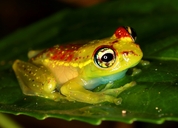|
Description
M 20-25 mm, F 30-34 mm. Tibiotarsal articulation usually reaches the tip of snout or beyond. Hand with some webbing, foot webbing 1(0), 2i(0), 2e(0), 3i(0), 3e(0), 4i/e(1), 5(0). Dorsal skin smooth. Dorsally green, with a more or less complete dorsolateral yellow stripe that fades at midbody. Small red dots and red patches above the eyes. Usually no brown pigments. Outer iris area bluish, iris periphery blue.
Similar species: Mainly B. bottae. The two species can occur in close syntopy, calling in the same shrubs along streams, and can be distinguished by the presence of usually at least some brown dorsal pigment in B. bottae.
Distribution and Habitat
Country distribution from AmphibiaWeb's database: Madagascar
Andasibe, Nahampoana, Ranomafana village, Vohiparara. It occurs between 300-900m asl in rainforest, generally along streams (Vences and Glaw 2008).
Life History, Abundance, Activity, and Special Behaviors
A pair was found in axillary amplexus along a stream in
woodland, during a rainy night in November. In January, calling males were found
after sunset along a brook, about one metre above the ground, near forest. Gravid
females with large yellowish eggs were still found in March.
Call: At Tolagnaro short double-click-notes (duration 60-85 ms) were
heard, repeated after intervals of 2800-5400 ms. Frequency ranges from 2.5 to
3.5 kHz and note repetition rate is about 0.3/s.
At Andasibe similar irregularly repeated double-click-notes were also often
heard. Beside this call type motivated males displayed a different acoustic
repertoire after heavy rainfall in December and January: 1) long series (duration:
5000-7000 ms) of many single click notes (note repetition rate about 10/s).
Two double-clicks occur at the end of such a series. Frequency is 3.8-4.5 kHz.
2) series of about 5 regularly repeated double-click-notes (about 2 such notes
per second), possibly with territorial function.
Eggs and tadpoles: One female deposited 260 glutinous light green
eggs measuring 2 mm in diameter (ref. 89). A female (SVL 34 mm) found in December
deposited about 300 yellowish eggs (egg diameter 2 mm, with jelly 3.5 mm. Tadpoles live in slow-running stretches of streams where the water
is shaded by abundant vegetation. They are blackish, covered with small bright
green spots. Total length in stage 25: 15-27 mm; in stages 31-41: 28-36 mm.
The eyes are directed laterally. The mouth is small and directed ventrally.
At midlength of the tail, the caudal musculature represents about 2/5 of the
total tail height. Tooth formula is 1/3+3//1+1/2 or 1/2+2//1+1/2. Metamorphosis
occurred in November; juveniles measure 11.5-14.0 mm SVL
Breeding takes place in streams (Vences and Glaw 2008).
Trends and Threats
Least Concern: wide distribution and large population. It occurs in the Parc National de Ranomafana, and in the Analamazoatra Special Reserve (Vences and Glaw 2008). Possible reasons for amphibian decline General habitat alteration and loss
Habitat modification from deforestation, or logging related activities
Intensified agriculture or grazing
Urbanization
Habitat fragmentation
Comments
Taken with permission from Glaw and Vences (2007).
References
Glaw, F., and Vences, M. (2007). Field Guide to the Amphibians and Reptiles of Madagascar. Third Edition. Vences and Glaw Verlag, Köln.
Vences, M. and Glaw, F. (2008). Boophis rappiodes. In: IUCN 2008. 2008 IUCN Red List of Threatened Species. www.iucnredlist.org. Downloaded on 14 April 2009.
Originally submitted by: Miguel Vences and Frank Glaw (first posted 2000-10-24)
Edited by: Henry Zhu (2009-05-05)Species Account Citation: AmphibiaWeb 2009 Boophis rappiodes <https://amphibiaweb.org/species/4358> University of California, Berkeley, CA, USA. Accessed May 24, 2025.
Feedback or comments about this page.
Citation: AmphibiaWeb. 2025. <https://amphibiaweb.org> University of California, Berkeley, CA, USA. Accessed 24 May 2025.
AmphibiaWeb's policy on data use.
| 